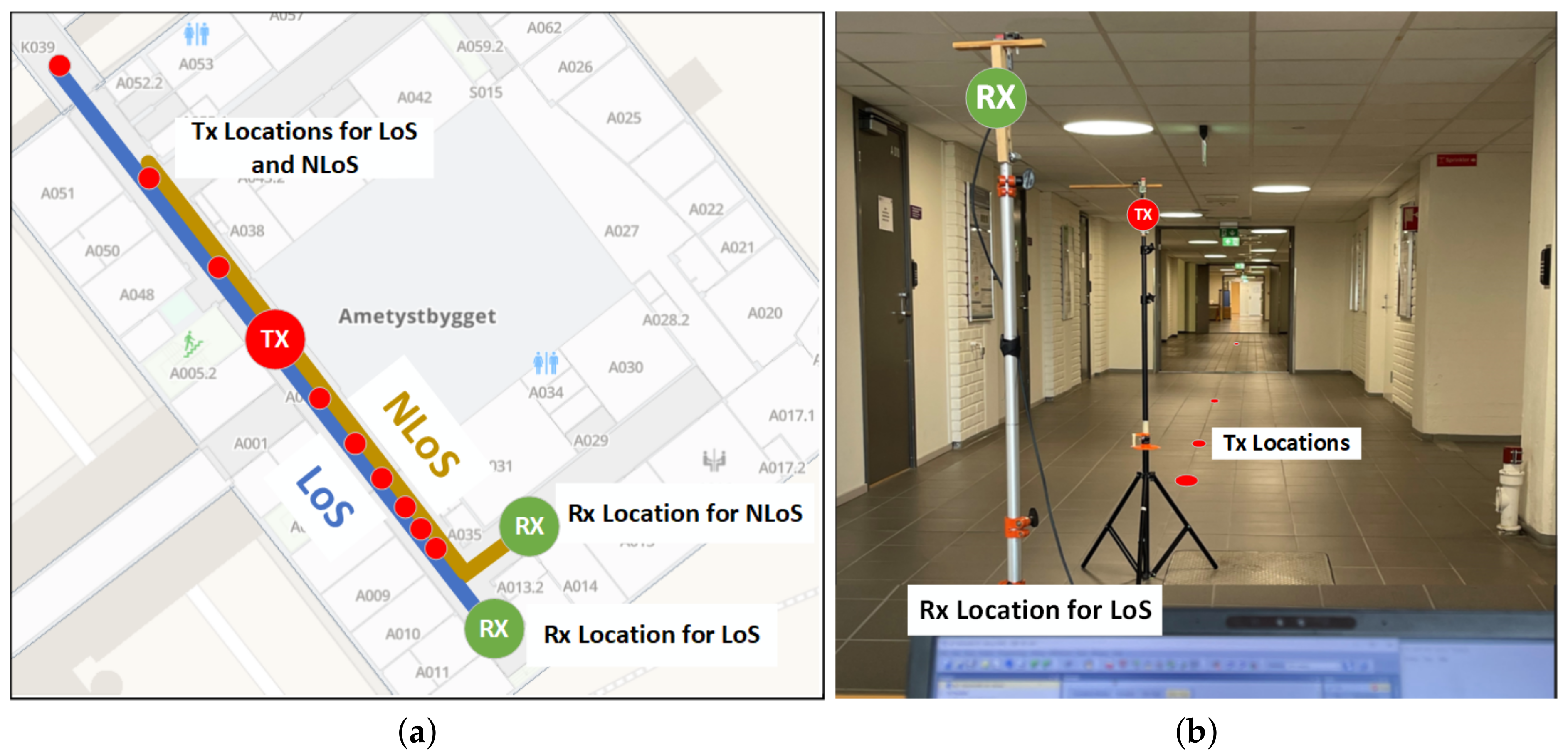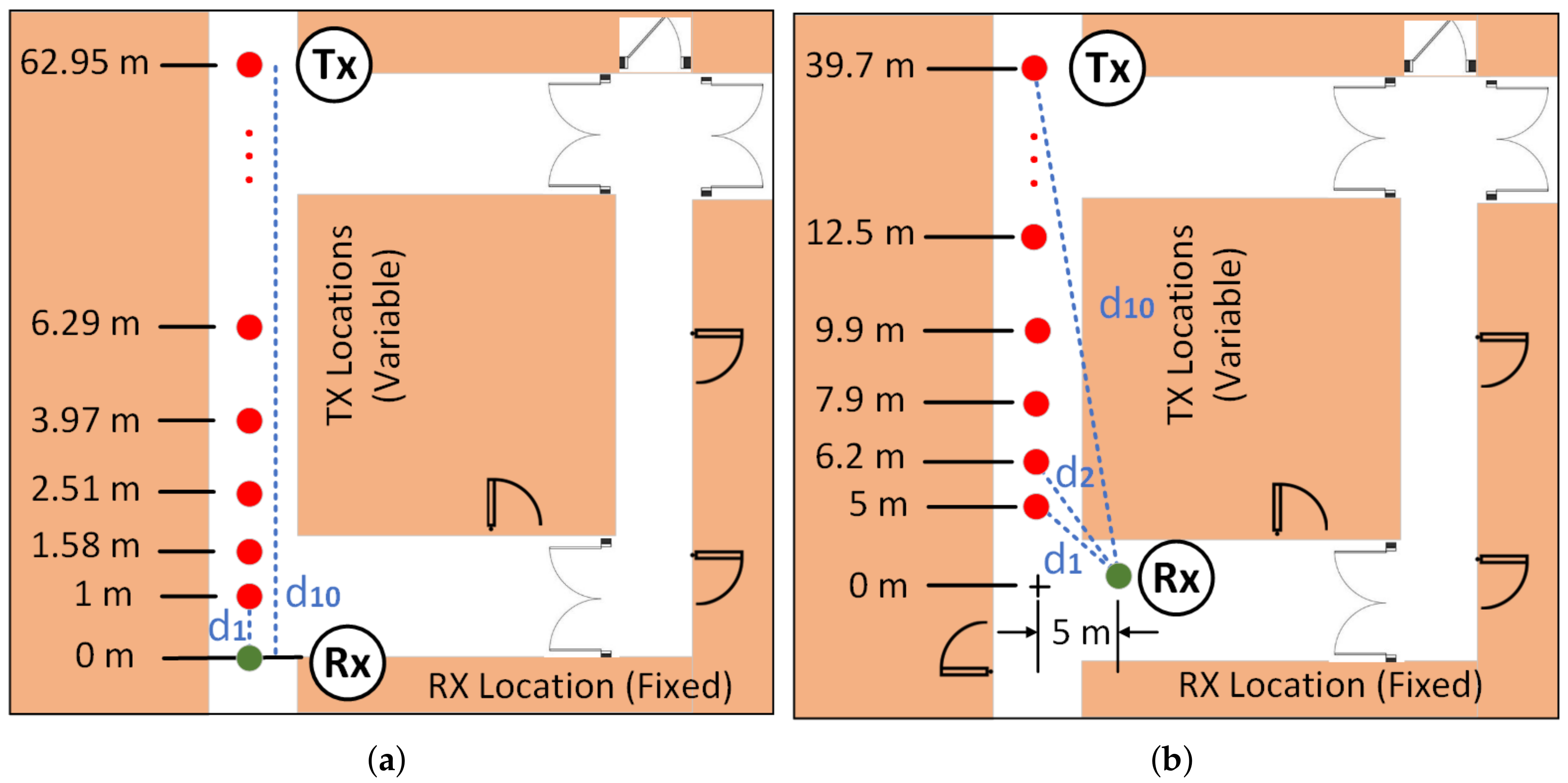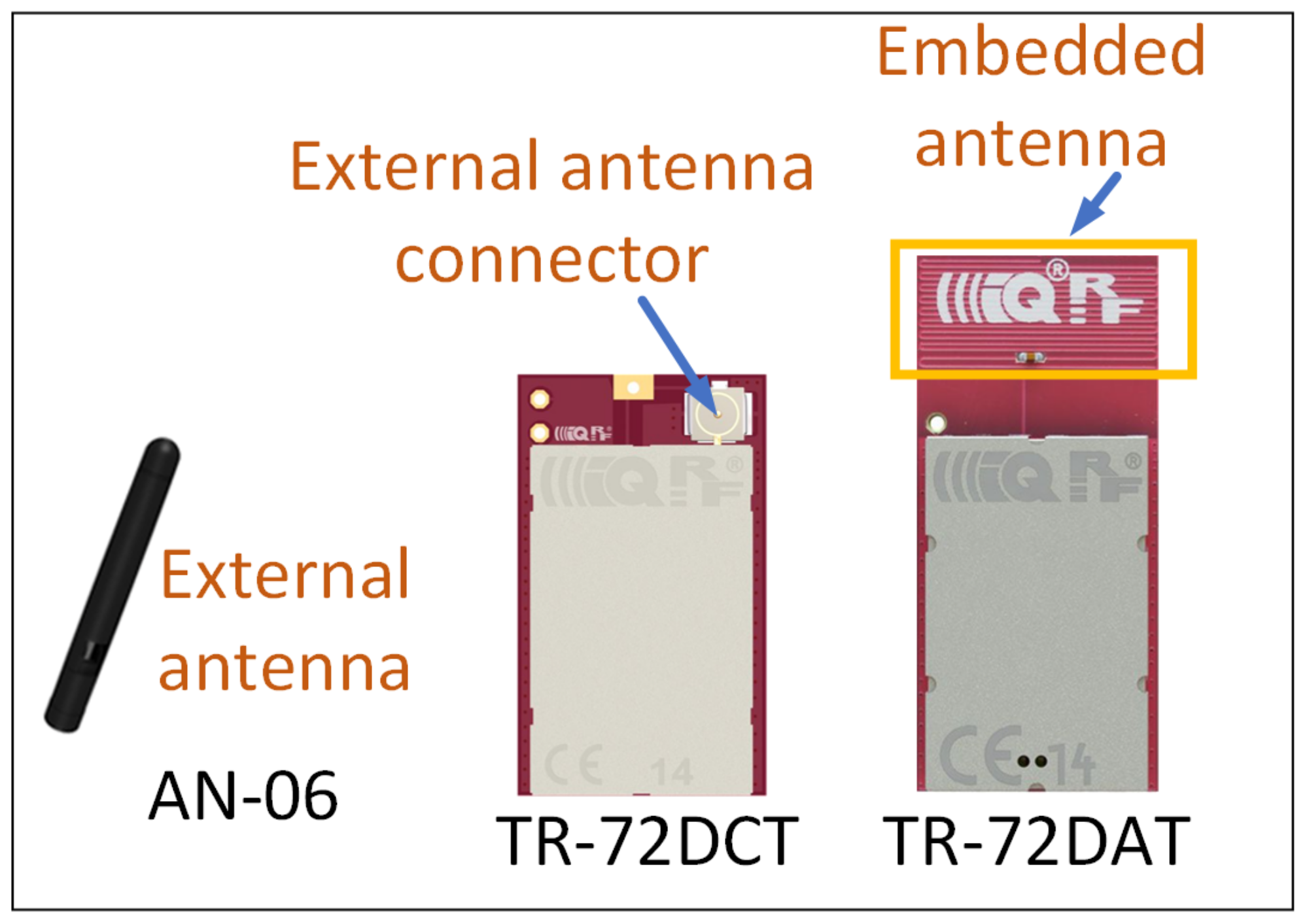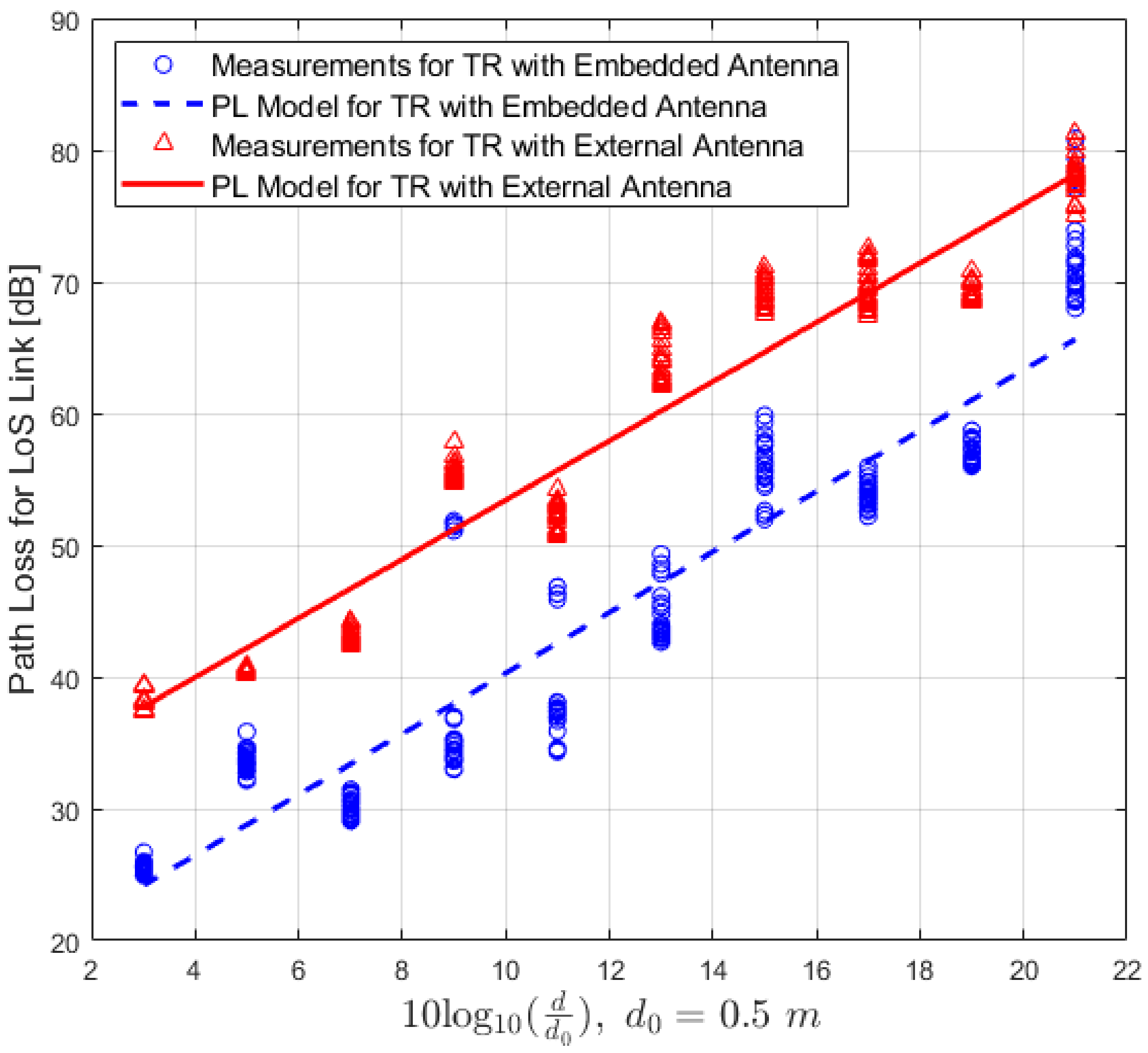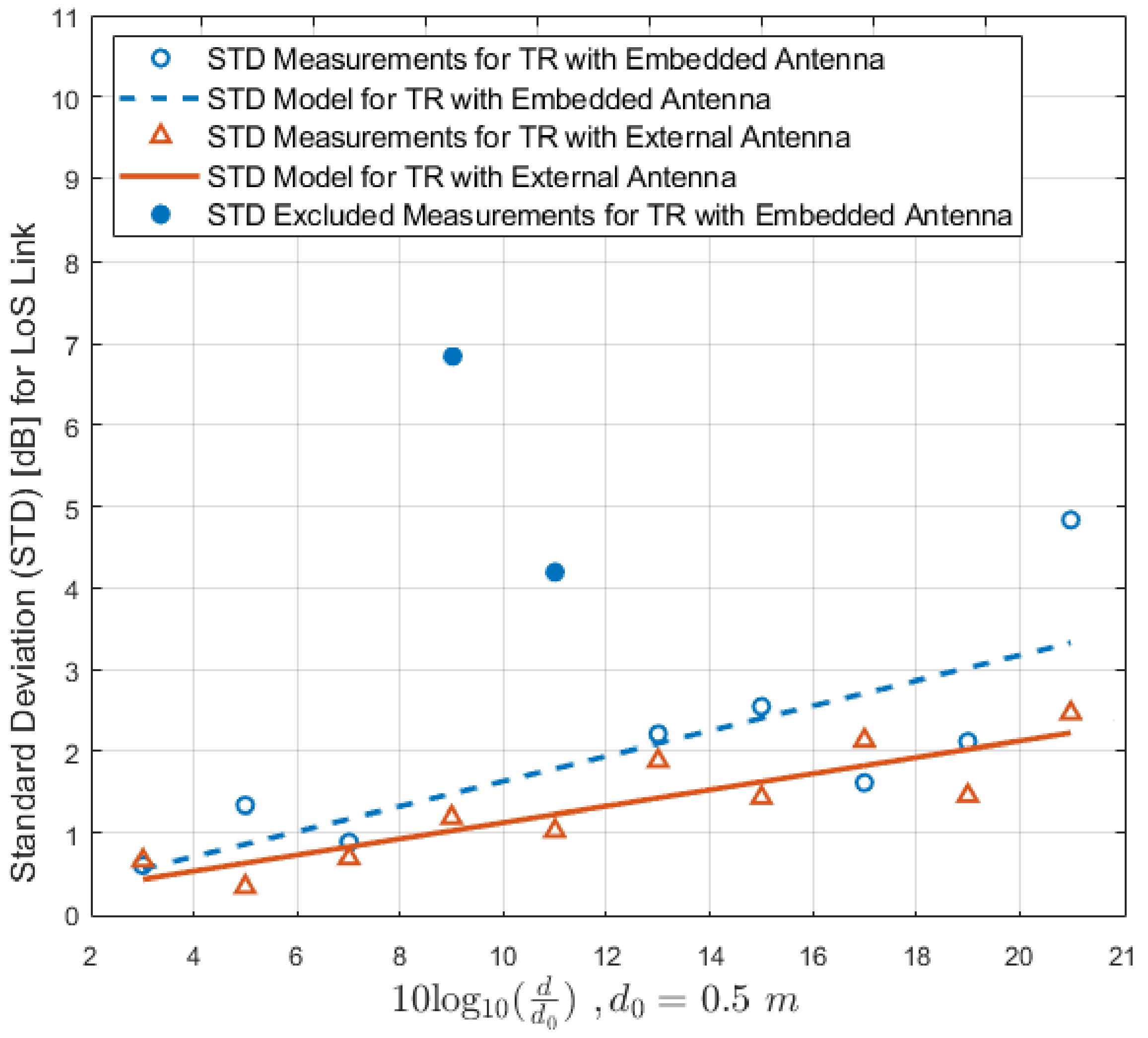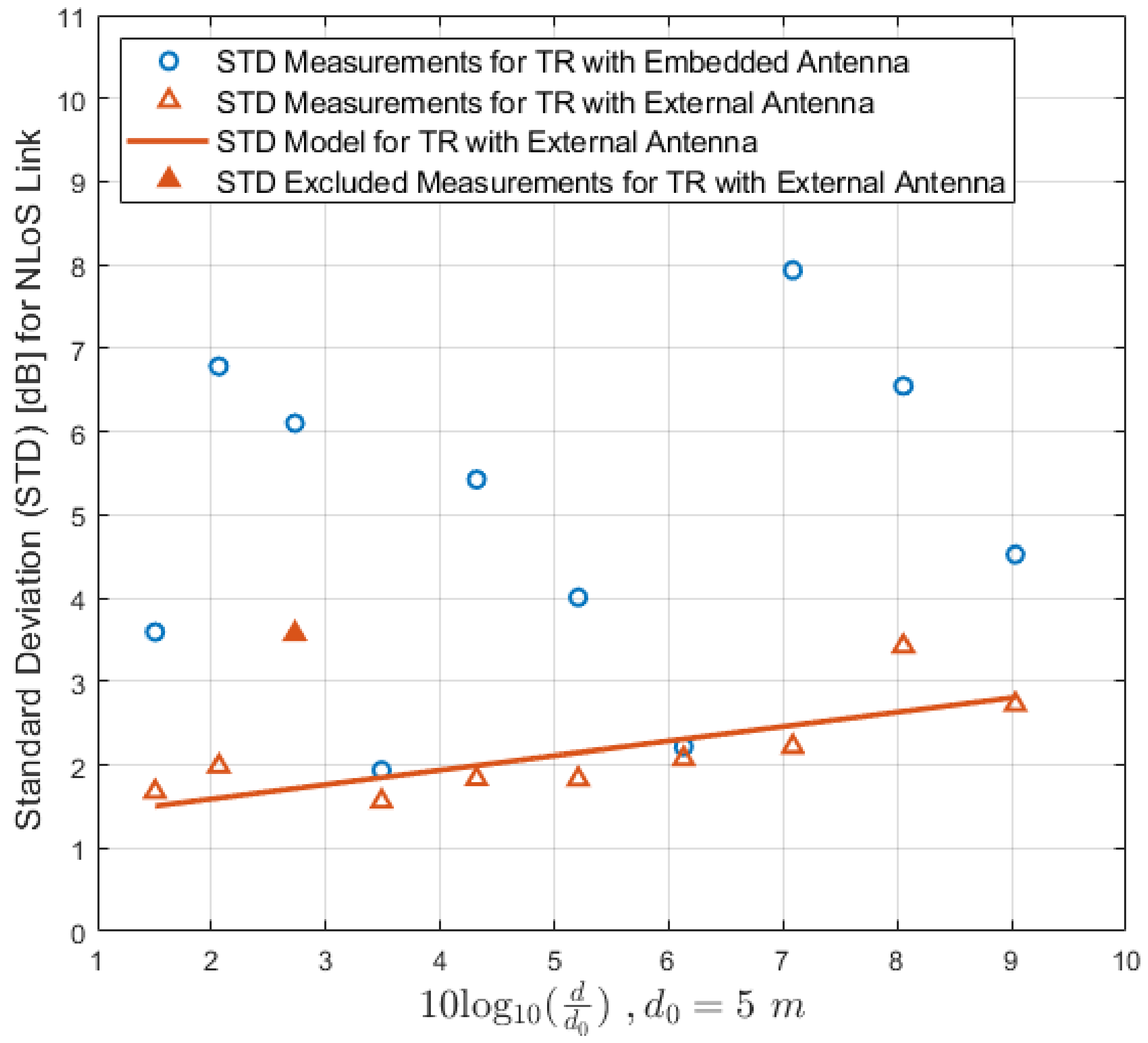1. Introduction
Recent developments in the Internet of Things (IoT) have led to the concept of smart buildings becoming popular due to the benefits and services offered [
1,
2]. These smart building and their applications can mainly be realized using a system of sensors connecting wirelessly, known as Wireless Sensor Networks (WSNs) [
3]. In the deployment of WSNs, one needs to give extra attention to, among others, the cost of the IoT wireless technology, its power consumption, and coverage. In this context, well-known wireless communication technologies, such as Low-Energy Bluetooth, Wi-Fi, and XBee/ZigBee, using unlicensed ISM (Industrial, Scientific, and Medical) bands are mostly preferred to be used in smart building applications [
4,
5,
6]. However, the main concern in their implementation can be linked to the limited network coverage. In order to solve this concern, Low-Power Wide Area Networks (LPWANs) technologies, such as SigFox and LoRa, have appeared [
7,
8]. Among the LPWANs technologies, LoRa has gained much more popularity as it provides large network coverage with low deployment cost and power consumption [
9].
Alternatively, IQRF technology has been introduced for the IoT commercial market [
10]. IQRF is a cost-effective IoT wireless technology that enables low-power connectivity. Its efficiency in IoT applications has been addressed by many studies in the literature [
11,
12,
13,
14,
15,
16]. Additionally, its usability in smart city applications is discussed by evaluating its network coverage performance in outdoor environments [
17]. Overall, from the results achieved from these studies, it can be inferred that IQRF can be used in many IoT solutions without a doubt of its effectiveness. Here, it is important to note that the coverage provided by IQRF in outdoor environments is relatively inferior when compared to LoRa. Nevertheless, it is still possible to compensate for this concern with the help of IQRF mesh network topology (IQMESH).
On the other hand, in recent years, the demands on smart buildings have increased around the world, as it offers an environment where people can live more securely and comfortably. The concept of smart buildings has become more intelligent because of the growing developments in the IoT based on the use of WSNs. For such networks, choosing a proper IoT technology enabling low-power consumption and wide network coverage is a key issue that needs to be addressed in order to realize smart building applications. In this context, IQRF appears to be one of the reasonable IoT technologies due to its efficiency in terms of low-power connectivity. However, in order to realize smart building applications using IQRF, the characteristics of IQRF links in indoor environments need to be comprehensively studied. In the literature, only a few studies that focus on the deployment of IQRF networks in indoor scenarios have been presented. In [
18], the operability and stability of the IQRF mesh topology in an indoor scenario are analysed using the measured Received Signal Strength Indicator (RSSI) values. The presented results show that IQRF performs well in terms of communication range, sensitivity, and power management. In [
19], the RSSI values of an IQRF network are measured in a multi-floor building. Instead of evaluating the communication range performance of IQRF, the main efforts are directed at the measurements of the packet transmission delay and the RSSI by varying the number of walls/ceilings. The obtained results show that the stability of the IQRF network is directly affected by the transmission power. In [
20], experimental measurements using IQRF nodes and simulations are performed by considering both indoor and outdoor scenarios in order to evaluate the performance of IQRF in terms of communication parameters, including range, network latency, and convergence. For indoor cases, measurements are performed in a room that is divided into grids with specific spacing to build a peer-to-peer (P2P) network. From the indoor measurements based on the RSSI values, it is concluded that IQRF provides good signal coverage in a typical indoor room consisting of multiple walls.
As can be deduced from the discussion above, propagation modelling techniques to achieve the accurate deployment of IQRF networks in indoor environments have not been studied in the literature yet. However, it is necessary to comprehensively analyse the propagation impairments that might affect the IQRF links. It is widely known that one of the most significant propagation impairments that can be considered is path loss (PL) [
21]. Basically, path loss defines the variation in the received signal power over the distance between the transmitter (Tx) and receiver (Rx). Inevitably, the environment in which the sensor network is planned to be deployed highly affects path loss. For this reason, the environmental conditions that might influence path loss are often taken into consideration. Thus, accurate path loss modelling is strictly required in the deployment of the IQRF network in indoor environments in order to predict the transmission range (network coverage) and performance.
This study aims to describe some preliminary propagation measurements that can be used to build WSN based on IQRF technology in an indoor environment. To this end, first, the propagation measurements were carried out in an indoor environment at 868 MHz through the IQRF transceivers (TRs). In the measurements, two different measurement scenarios are used within the context of a P2P configured system. In the first scenario, IQRF TRs were assumed to be connected to each other in the same corridor of a building in a Line-of-Sight (LoS) link. In the second scenario, a simple Non-Line-of-Sight (NLoS) link was built by considering a single knife-edge link where IQRF TRs were assumed to be connected to each other at two perpendicular corridors. Then, for the sake of simplicity, well-known empirical path loss models, namely the Log-distance, ITU, and WINNER II, were accounted for, and their prediction accuracies were assessed by comparing the predicted and measured PL values. From the comparison results, the empirical PL models that fit the measurements with more prediction accuracy were proposed to be used for the deployment of IQRF networks in the considered indoor environments. To the best of our knowledge, this is the first study that provides the assessment of popular empirical path loss models for IQRF links in an indoor environment.
The structure of this article is organized as follows.
Section 2 discusses empirical PL models that are compared with the IQRF-obtained PL models for IQRF network deployment in the indoor environment. The experimental setup and the measurements are described in
Section 3. The measurement results and their analyses are then presented in
Section 4. The article is concluded in
Section 5.
4. Results Analysis and Discussion
4.1. IQRF Path Loss Obtained Models
In order to study the performance of the IQRF network in the sub-GHz band in an indoor environment, we pay close attention to the characteristics of signal propagation in the wireless channel of this environment by exploring both LoS and NLoS scenarios. Therefore, the received signal is recorded from both IQRF TRs with embedded and external antennas and from the recorded data, the path loss is derived. The path loss of Equation (
3) is estimated using
where
is the power of the transmitter,
is the gain of the transmitter antenna,
is the gain of the receiver antenna, and
is the measured received signal power. The obtained path loss values from
Figure 4, together with the normalized log-distance are used as input in regression analysis to obtain the path loss models. The regression analysis of the data applied the least squares method (LSM), and the resulting models are presented in
Figure 4 and
Figure 5 for LoS and NLoS links, respectively. The Packet Delivery Ratio (PDR) for the measured data at each location is also calculated, and the PDR values for the corresponding scenarios, LoS and NLoS, are shown in
Table 3 and
Table 4, respectively. It is worth noting that the PDR is only used as an indication to validate the received data for path loss calculation, and it is not intended to be studied in this work. Hence, only values of the received power at the locations where the total number of successfully received packets is higher than
are included in the path loss calculation. The obtained models’ regression parameters, such as path loss exponent (PE)
n, losses
at a far-field reference distance
(
m for LoS and
m for NLoS), the correlation factor between measured and predicted values represented by
, and finally, the fitting error
for LoS and NLoS links, are presented in
Table 6 and
Table 7, respectively.
In addition, the standard deviation (STD) of the log-normal distribution at each location is also calculated using the recorded raw data from both types of TRs in each scenario. Hence, four sets of STD data are obtained. In order to observe the changes in the STD versus the Tx-Rx separation distance, each set of the calculated STD data is fitted with a line using LSM. However, it is worth mentioning that the STD dataset values of the TR with an embedded antenna in the NLoS scenario are not fitted, as the correlation factor, in this case, will be very low for linear regression. Moreover, STD data values for locations 4 and 5 of TR with an embedded antenna in the LoS scenario and the one for location 3 of TR with an external antenna in the NLoS scenario are considered outliers and are excluded from the fitting.
The four STD datasets and the corresponding fittings for the LoS and NLoS scenarios are presented in
Figure 6 and
Figure 7, respectively.
From
Table 6 and
Table 7, the PE results are promising in both scenarios for both types of IQRF TRs. In the LoS scenario, approximately similar path loss exponents (PEs) are obtained;
and
for TR with an embedded antenna and the TR with an external antenna, respectively. However, a slight difference in PE is observed in the NLoS scenario;
for TR with an embedded antenna compared to the one with an external antenna, where
. This will result in a faster decrease in power for TRs with an embedded antenna compared to the ones with an external antenna. Moreover, a difference in power (offset) between the obtained path loss models for both types of TRs in both LoS and NLoS scenarios can be seen in
Figure 4 and
Figure 5, respectively. This is not ideal and could be explained by the instability of IQRF TRs with an embedded antenna, as discussed in [
17]. When comparing the performances of both types of TRs, the results presented in [
17] show that IQRF TRs with an embedded antenna (MLDA) show not only a drop in power due to its lower gain (−8.5 dB) but also a larger spread of the recorded values at each location compared to TRs with an external antenna (SLDA). This can also be observed in
Figure 6 and
Figure 7, where IQRF TRs with an embedded antenna tend to have a larger spread when compared to the IQRF TRs with an external antenna.
Overall, the results show that using IQRF TRs with an external antenna provides a stable received power at the expense of an additional part (antenna) and, accordingly, a larger size of the node in practice. However, if the size of the node is considered a limitation of the system, TRs with an embedded antenna are still a good option in shorter distances, especially in a LoS environment.
4.2. Comparison with Other Models
This section is devoted to evaluating the accuracy of IQRF-obtained models and their applicability and usability in the planning and deployment of IQRF wireless networks in an indoor environment. Therefore, the obtained IQRF PL models are compared with the models presented in
Section 2. It is important to note that the choice of the empirical PL models is based on the similarities between the chosen model and the measurement conditions, such as the environment (indoor), the operating frequency, and the PE.
Figure 8 and
Figure 9 depict the IQRF PL models for both types of TRs obtained for both scenarios, LoS and NLoS, respectively. For easier comparison, we also draw the same set of models presented in
Section 2 on both figures.
Although there is a difference in the power between IQRF PL models, as discussed earlier, still IQRF PL with an embedded antenna is compared with other empirical indoor models. The RMSE between IQRF PL obtained models, and each of the other indoor models for both LoS and NLoS scenarios is calculated, and the results are presented in
Table 8. Based on the obtained results, in the LoS scenario, the ITU-1 model has better accuracy for both IQRF TRs with an embedded antenna and with an external antenna with minimal errors of 7.18 and 8.37 dB, respectively. In addition, the corresponding PEs are also close to the one of the ITU-1 model. However, for the best use of this model in IQRF network planning, an offset in power (losses) must be added to the ITU-1 model, which is approximately the RMSE error found. Thus, −7 dB for the IQRF model with an embedded antenna and +8 dB for the IQRF model with an external antenna.
On the other side, in the NLoS scenario, the best match for the IQRF model with an embedded antenna is ITU-3, with an added power offset of approximately +1.5 dB. Moreover, for the IQRF model with an external antenna, the closest models that can be considered are WINNER-2 and ITU-3, with minimal errors of 6.65 and 8.55 dB, respectively. The offset in power, in this case, is approximately +8 dB to be added to the ITU-3 model and approximately +6 dB to be added to the WINNER-2 model. However, PE should be considered if WINNER-2 is the chosen model for this case.
Finally, it is worth mentioning that the estimated range of IQRF
is also calculated using the obtained models and the sensitivity of the Rx transceiver (−131 dB). The results are presented in
Table 6 and
Table 7 for LoS and NLoS links, respectively.
5. Conclusions
The deployment of IQRF networks in indoor environments requires accurate signal analysis and PL modelling to estimate network coverage and performance. In this paper, preliminary propagation measurements using IQRF TRs that operate on the 868 MHz band were conducted. The PL parameters were measured in an indoor corridor environment for LoS and NLoS links using IQRF TRs with an embedded antenna and with an external antenna. After that, indoor empirical PL models for the IQRF network are obtained. In order to analyse the accuracy of IQRF PL models, the obtained models are compared with other well-known indoor models. The comparison results show that in the LoS scenario, the model that better matches the IQRF models obtained using TRs with embedded and external antennas is the ITU-1 path loss model that is established at 800 MHz in an office environment. On the other hand, for the NLoS scenario, the best fit with the IQRF PL model obtained using an embedded antenna is ITU-3 at 900 MHz in commercial areas. While for the IQRF PL model using TR with an external antenna, both ITU-3 at 900 MHz in commercial areas and WINNERII-2 for a NLoS corridor are considered. Additionally, the STD at each location is also calculated for the different TRs and scenarios. Finally, the maximum range values of both types of IQRF TRs are also presented.
This work is a preliminary study of IQRF in an indoor environment. Another future study is planned for the same environment by conducting comprehensive measurements that cover a larger portion of the indoor scenarios, such as inside rooms or between floors.
